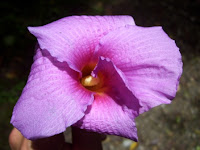A great small hotel at Kelly Creek - all dark hardwood, louvres, ceiling fans and swampy jungle noises. Hoteliers Andreas (from Madrid) and Marie-Claude (from France) served a stunning paella with homemade sangria that, like this hotel, was a oasis of exotic culture amidst this exotic Caribbean tropical rainforest.
Cahuita: great animals, good snorkling, hot sticky weather, torturous non-stop reggae music (so mind-numbingly everpresent as to warrant including in a CIA psychological warfare manual) and two legged snakes (bare-footed Rasta-men with no shirts, dreadlocks in green, yellow and red knit hair bags, wrap-around sunglasses and a look like they would steal their mother's wedding ring).
Cahuita village sign - the "In One Other Tours", "Hot Water Fans" and "Bid Watching" sound interesting

Abandoned truck - left for 9 years. The jungle reclaims all.
 Janet and new friend Verde at the Kelly Creek Lodge. This "Mealy Parrot" talked a lot - "hola" "hello" "I'm a parrot" and laughed just like Janet (and Eloise, Janet's mother...). Verde is jealously wary and agressive to any man, but eventually took some scrambled egg from my fingertips. That was close enough to that beak...
Janet and new friend Verde at the Kelly Creek Lodge. This "Mealy Parrot" talked a lot - "hola" "hello" "I'm a parrot" and laughed just like Janet (and Eloise, Janet's mother...). Verde is jealously wary and agressive to any man, but eventually took some scrambled egg from my fingertips. That was close enough to that beak... Janet and Verde look from our room porch to the main building and restaurant at Kelly Creek Lodge
Night time means mosquito nets in the coastal tropics. This hotel was right out of Casablanca.
Iguana at Kelly Creek. Coming for fruit left in trees.
Roberto (L) and girlfriend (R) caimans in stagnant water lagoon (Kelly Creek) right next to our hotel. Roberto came to shore when called by Andreas, for a meal of raw chicken. Swimming not recommended.
Tangle of mangrove swamp on trail in Cahuita National Park.
Howler monkey in Cahuita NP
White faced monkey, Cahuita NP. These guys can be agressive and jump on your back to get food in your backpack.
Young white-faced monkeys clearly saying, "Hey wadda ya wanna do now?", just like human kids.







































+and+Turrialba+(R)+volcanoes.JPG)







 Janet beside a Walking Palm. It has no trunk, just root shoots that seek better water and sun, and progressively move the entire tree through the forest.
Janet beside a Walking Palm. It has no trunk, just root shoots that seek better water and sun, and progressively move the entire tree through the forest.


